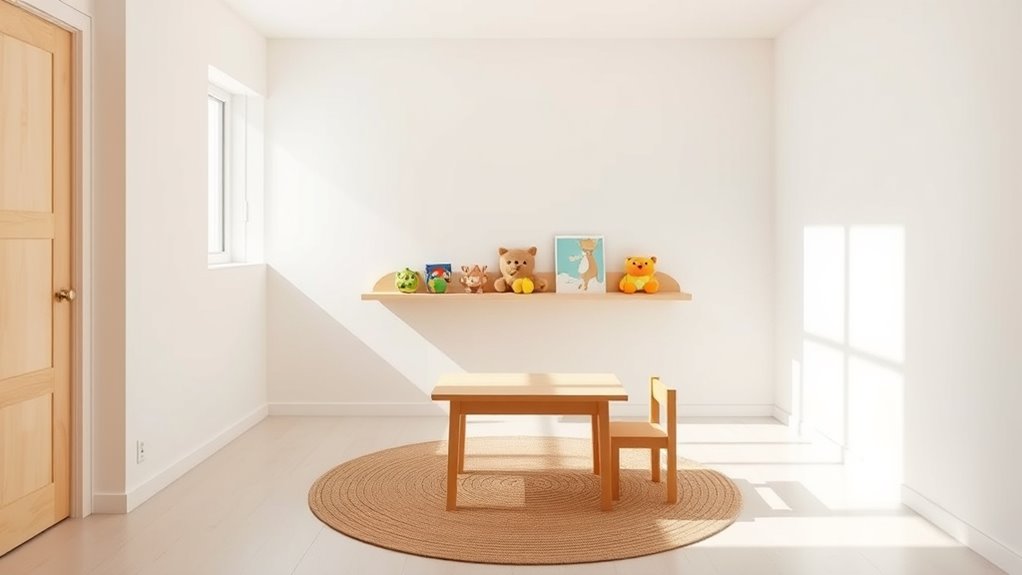To design a minimalist playroom on any budget, focus on smart, organized storage like open shelves, baskets, and multi-purpose furniture to keep clutter at bay. Stick to neutral colors such as whites, beiges, and soft grays, adding subtle accents with cushions or artwork. Use natural materials like wood or bamboo for warmth and choose versatile, space-saving solutions like wall-mounted shelves. Keep the space simple yet functional, and if you continue exploring, you’ll discover how to create a calm, stylish haven easily.
Key Takeaways
- Choose neutral colors and natural materials to create a calming, cohesive environment.
- Incorporate versatile, modular storage options like open shelves, baskets, and multi-purpose furniture.
- Maximize space with vertical storage solutions and wall-mounted shelves to keep floors clear.
- Use budget-friendly accessories such as rugs, cushions, and artwork in subtle, complementary tones.
- Focus on simple, functional furniture and hidden storage to maintain a clutter-free, adaptable play area.

A minimalist playroom design creates a calm, clutter-free space where children can explore and learn freely. To achieve this, you need to focus on smart storage solutions that keep toys and supplies organized without overwhelming the room. Opt for simple storage options like open shelves, cubbies, or multi-purpose furniture that doubles as storage. Baskets and bins are excellent for hiding clutter and can be swapped out easily, maintaining a tidy atmosphere. Look for sleek, unobtrusive pieces that blend seamlessly into the room’s overall aesthetic, ensuring that storage doesn’t become an eyesore.
Color palettes play a *vital* role in establishing a minimalist vibe. Stick to a neutral base—think soft whites, warm beiges, or muted grays—as they create a serene environment that feels spacious and inviting. You can add subtle pops of color through accessories like cushions, rugs, or artwork, but keep these accents minimal. The goal is to avoid visual clutter, which can make a space feel chaotic rather than calming. By choosing a cohesive color palette, you help your child focus and foster a sense of tranquility, making the playroom a peaceful retreat for both playtime and rest.
When selecting storage solutions, prioritize versatility. Modular units that can be reconfigured or expanded as your child grows are ideal because they adapt to changing needs. Consider vertical storage to maximize space, especially if the room is small. Wall-mounted shelves or pegboards keep toys off the floor, fostering a sense of order. Incorporate hidden storage options beneath furniture or within built-in units to reduce visual clutter and keep the room streamlined.
In terms of color palettes, keep the scheme simple but warm. Soft, muted tones promote relaxation and help create a cohesive look. Adding a touch of natural materials like wood or bamboo in storage bins or furniture can introduce warmth and texture without disrupting the minimalist aesthetic. Light-colored rugs and curtains also brighten the space while maintaining a clean, uncluttered appearance.
Ultimately, designing a minimalist playroom on any budget is about thoughtful choices. Invest in versatile storage solutions that keep things tidy, and select a calming color palette that promotes focus and relaxation. With a little creativity and planning, you can craft a beautiful, functional space where your child can thrive, learn, and play without the chaos of clutter. Keep it simple, intentional, and adaptable, and you’ll create a playroom that’s both stylish and practical.
Frequently Asked Questions
How Can I Incorporate Educational Elements Into a Minimalist Playroom?
You can incorporate educational elements by selecting simple, multifunctional educational toys that promote learning without cluttering the space. Create designated learning zones with clear, open areas for activities like reading or puzzles. Keep the design minimal by using neutral colors and streamlined storage to hide toys when not in use. This way, your playroom stays tidy, while encouraging exploration and development through thoughtfully chosen educational toys and organized learning zones.
What Are Eco-Friendly Materials Suitable for a Minimalist Playroom?
You can incorporate eco-friendly materials like sustainable wood for furniture and shelving, which are durable and reduce environmental impact. Recycled textiles work well for cushions, rugs, and soft toys, adding comfort without harming the planet. Opt for non-toxic paints and natural fiber fabrics to keep the space safe for children. These choices not only promote sustainability but also create a calming, minimalist atmosphere perfect for play and learning.
How Do I Ensure Safety Without Cluttering the Space?
Think of your playroom as a delicate balance beam—each step requires careful placement. To keep it safe without clutter, choose sleek storage solutions that hide toys yet keep essentials within reach. Add safety accessories like corner protectors and outlet covers, ensuring peace of mind. Regularly tidy up and evaluate items, so your space remains a sanctuary for your little one, where safety and simplicity dance in harmony.
Can a Minimalist Playroom Be Easily Adaptable as Children Grow?
Yes, a minimalist playroom can easily adapt as your children grow. You can focus on growth adaptability by choosing furniture with flexibility, like adjustable shelves or multi-purpose pieces. Keep the layout simple and modular, allowing you to swap out or reposition items as needed. This way, the space remains functional and fresh, accommodating your child’s changing interests and needs without clutter or costly renovations.
What Lighting Options Enhance a Minimalist Playroom Ambiance?
You can enhance a minimalist playroom’s ambiance with natural light and ambient lighting. Keep windows unobstructed to let in sunlight, creating a bright, cheerful space. Add simple, sleek fixtures like pendant lights or wall-mounted lamps for soft, ambient glow during evening hours. Combining natural light with well-chosen ambient lighting makes the room feel inviting, calming, and perfect for play and relaxation, all while maintaining that minimalist aesthetic.
Conclusion
Now that you’ve crafted a minimalist playroom, remember that simplicity sparks creativity. Stick to clean lines, neutral tones, and functional pieces—your little one will love the calm space. Don’t forget, even Leonardo da Vinci knew that less is more. With these budget-friendly tips, you’ve created a stylish, clutter-free haven for play and imagination. Enjoy watching your child explore in their beautifully simple sanctuary, where every item has a purpose and nothing distracts from the joy of discovery.










